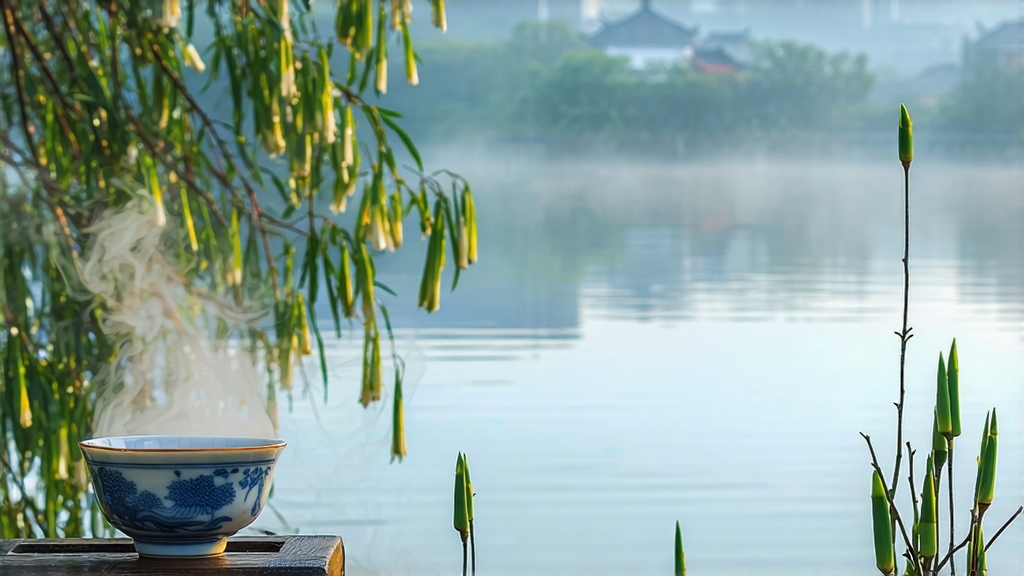
Tucked between the mist-cradled hills of Dongting Mountain and the rippling waters of Taihu Lake, Biluochun—literally “Green Snail Spring”—has been seducing tea lovers since the late Ming dynasty. According to local chronicles, a traveling monk in 1675 noticed an extraordinary fragrance drifting from wild tea shrubs clinging to peach, plum and apricot trees. After villagers brewed the tiny curled leaves, the infusion tasted so hauntingly floral that they named the tea “Scary Fragrance”; only later did Emperor Kangxi, on his southern inspection tour, rechristen it “Biluochun” for its snail-shell shape and spring harvest. From that imperial moment onward, the delicate green spirals became one of China’s Ten Famous Teas, yet they remain stubbornly local: 99 % of authentic Biluochun still comes from the two tiny islands of Dongting Dongshan and Xishan in Jiangsu Province, where the subtropical lake climate traps morning fog that acts like a natural shade cloth, slowing photosynthesis and concentrating amino acids.
Although connoisseurs speak of “Biluochun” as a single tea, the micro-region offers three distinct grades tied to elevation and terroir. “Qingming Biluochun,” picked before April 5, contains only the unopened bud and half-open first leaf; the buds appear downy white against jade green, and the liquor glows almost neon. “Pre-Guyu Biluochun,” harvested before April 20, adds one full leaf, trading some delicacy for a rounder, nuttier cup. Finally, “Spring Rain Biluochun,” plucked in early May, includes two leaves and a bud, yielding a bolder, slightly astringent brew favored in northern China for pairing with oily dishes. Beyond these temporal grades, cultivar nuances matter: the traditional “Xiao Ye” (small-leaf) strain delivers the signature orchid-peach aroma, while the newer “Fuding Da Bai” grafting increases downiness but can mute fragrance if over-fired.
The crafting of Biluochun is a ballet of heat, pressure and timing that unfolds in six acts within a single day. First, pickers fan out at dawn when the lake mist still beads on the leaf surface; any dew left on the bush will oxidize the bud and flatten flavor. Leaves are delivered in bamboo baskets lined with fresh fig leaves—an old trick to add a whisper of fruit esters. Withering is skipped; instead, the leaves undergo “shaqing” (kill-green) within two hours of plucking. A wok heated to 180 °C is rubbed with a slab of pork lard, then polished with tea-oil paper; this seasons the metal and prevents sticking. The tea master tosses 150 g of buds into the wok, pressing and rolling them against the surface with bare fingers for exactly 3.5 minutes. The gesture looks like kneading dough, yet the pressure must be light enough to keep the bud intact while rupturing cell walls to release aromatic enzymes. Next comes “cuotuan,” the spiral-shaping step: the partially cooled leaves are rolled between palm and wok wall in concentric circles until they resemble tiny snail shells. A second firing at 120 °C reduces moisture to 20 %, followed by a low 70 °C bake that locks in fragrance. The entire process consumes 70 000 buds—and eight hours of continuous hand work—to yield just 500 g of finished tea.
Brewing Biluochun is an exercise in restraint. Its downy buds are so delicate that pouring boiling water directly will scald them into cabbage-like bitterness. The classic Taihu method uses a 150 ml pear-shaped glass pitcher pre-warmed with 75 °C water. Three grams of tea—about a heaping teaspoon—are sprinkled onto the surface; the buds stand upright for a moment, then drift down like green snow. After 45 seconds the liquor turns pale chartreuse and releases a scent somewhere between white peach and Cymbidium orchid. The first infusion is sipped for aroma; the second, at 30 seconds, offers the fullest balance of sweetness and umami; the third, at 50 seconds, introduces a faint mineral note reminiscent of wet slate. Beyond four infusions the tea fades, but locals stretch it to six by raising the temperature 5 °C each time, a practice called “chasing the spring.”
Tasting Biluochun demands three senses working in